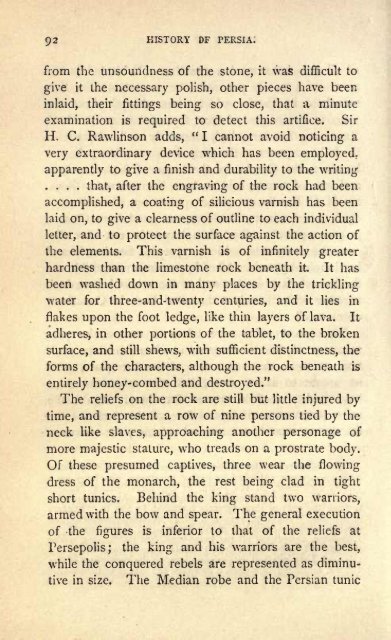Persia from the Earliest Period to the Arab
Persia from the Earliest Period to the Arab
Persia from the Earliest Period to the Arab
You also want an ePaper? Increase the reach of your titles
YUMPU automatically turns print PDFs into web optimized ePapers that Google loves.
Q2 HISTORY OF PERSIA.<br />
<strong>from</strong> <strong>the</strong> unsoundness of <strong>the</strong> s<strong>to</strong>ne,<br />
it was difficult <strong>to</strong><br />
have been<br />
give it <strong>the</strong> necessary polish, o<strong>the</strong>r pieces<br />
inlaid, <strong>the</strong>ir fittings being so close, that a minute<br />
examination is required<br />
H. C. Rawlinson adds,<br />
<strong>to</strong> detect this artifice. Sir<br />
" I cannot avoid noticing a<br />
very extraordinary device which has been employed,<br />
apparently <strong>to</strong> give a finish and durability <strong>to</strong> <strong>the</strong> writing<br />
.... that, after <strong>the</strong> engraving of <strong>the</strong> rock had been<br />
accomplished, a coating<br />
of silicious varnish has been<br />
laid on, <strong>to</strong> give a clearness of outline <strong>to</strong> each individual<br />
letter, and <strong>to</strong> protect <strong>the</strong> surface against <strong>the</strong> action of<br />
<strong>the</strong> elements. This varnish is of infinitely greater<br />
hardness than <strong>the</strong> limes<strong>to</strong>ne rock beneath it. It has<br />
been washed down in many places by <strong>the</strong> trickling<br />
water for three-and-twenty centuries, and it lies in<br />
flakes upon <strong>the</strong> foot ledge, like thin layers of lava. It<br />
adheres, in o<strong>the</strong>r portions of <strong>the</strong> tablet, <strong>to</strong> <strong>the</strong> broken<br />
surface, and still shews, with sufficient distinctness, <strong>the</strong><br />
forms of <strong>the</strong> characters, although <strong>the</strong> rock beneath is<br />
entirely honey-combed and destroyed."<br />
The reliefs on <strong>the</strong> rock are still but little injured by<br />
time, and represent a row of nine persons tied by <strong>the</strong><br />
neck like slaves, approaching ano<strong>the</strong>r personage of<br />
more majestic stature, who treads on a prostrate body.<br />
Of <strong>the</strong>se presumed captives, three wear <strong>the</strong> flowing<br />
dress of <strong>the</strong> monarch, <strong>the</strong> rest being clad in tight<br />
short tunics. Behind <strong>the</strong> king stand two warriors,<br />
armed with <strong>the</strong> bow and spear. The general execution<br />
of -<strong>the</strong> figures<br />
is inferior <strong>to</strong> that of <strong>the</strong> reliefs at<br />
Persepolis; <strong>the</strong> king and his warriors are <strong>the</strong> best,<br />
while <strong>the</strong> conquered rebels are represented as diminu-<br />
tive in size. The Median robe and <strong>the</strong> <strong>Persia</strong>n tunic

















